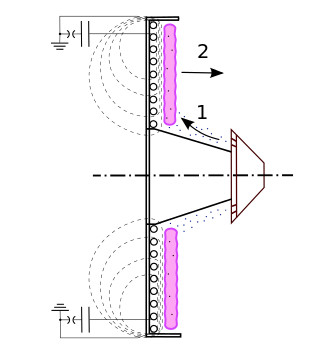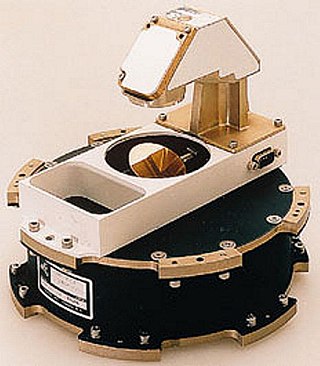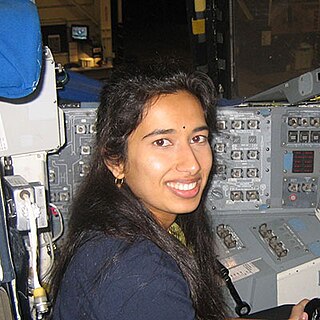Related Research Articles

In spacecraft propulsion, a Hall-effect thruster (HET) is a type of ion thruster in which the propellant is accelerated by an electric field. Hall-effect thrusters are sometimes referred to as Hall thrusters or Hall-current thrusters. Hall-effect thrusters use a magnetic field to limit the electrons' axial motion and then use them to ionize propellant, efficiently accelerate the ions to produce thrust, and neutralize the ions in the plume. The Hall-effect thruster is classed as a moderate specific impulse space propulsion technology and has benefited from considerable theoretical and experimental research since the 1960s.

An ion thruster, ion drive, or ion engine is a form of electric propulsion used for spacecraft propulsion. It creates thrust by accelerating ions using electricity.

A pulsed inductive thruster (PIT) is a form of ion thruster, used in spacecraft propulsion. It is a plasma propulsion engine using perpendicular electric and magnetic fields to accelerate a propellant with no electrode.

A reaction wheel (RW) is used primarily by spacecraft for three-axis attitude control, and does not require rockets or external applicators of torque. They provide a high pointing accuracy, and are particularly useful when the spacecraft must be rotated by very small amounts, such as keeping a telescope pointed at a star.

Aerobraking is a spaceflight maneuver that reduces the high point of an elliptical orbit (apoapsis) by flying the vehicle through the atmosphere at the low point of the orbit (periapsis). The resulting drag slows the spacecraft. Aerobraking is used when a spacecraft requires a low orbit after arriving at a body with an atmosphere, as it requires less fuel than using propulsion to slow down.

Laser propulsion is a form of beam-powered propulsion where the energy source is a remote laser system and separate from the reaction mass. This form of propulsion differs from a conventional chemical rocket where both energy and reaction mass come from the solid or liquid propellants carried on board the vehicle.

Aerocapture is an orbital transfer maneuver in which a spacecraft uses aerodynamic drag force from a single pass through a planetary atmosphere to decelerate and achieve orbit insertion.

Spacecraft electric propulsion is a type of spacecraft propulsion technique that uses electrostatic or electromagnetic fields to accelerate mass to high speed and thus generate thrust to modify the velocity of a spacecraft in orbit. The propulsion system is controlled by power electronics.

Gregory Errol Chamitoff is a Canadian-born American engineer and former NASA astronaut. He has been to space twice, spending 6 months aboard the ISS across Expedition 17 and 18 in 2008, and another 15 days as part of STS-134 in 2011. STS-134 was the last of Space Shuttle Endeavour which delivered the Alpha Magnetic Spectrometer and completed the US Orbital Segment.

The idea of sending humans to Mars has been the subject of aerospace engineering and scientific studies since the late 1940s as part of the broader exploration of Mars. Long-term proposals have included sending settlers and terraforming the planet. Proposals for human missions to Mars have come from agencies such as NASA, CNSA, the European Space Agency, Boeing, and SpaceX. As of 2023, only robotic landers and rovers have been on Mars. The farthest humans have been beyond Earth is the Moon, under the Apollo program.

An orbital propellant depot is a cache of propellant that is placed in orbit around Earth or another body to allow spacecraft or the transfer stage of the spacecraft to be fueled in space. It is one of the types of space resource depots that have been proposed for enabling infrastructure-based space exploration. Many different depot concepts exist depending on the type of fuel to be supplied, location, or type of depot which may also include a propellant tanker that delivers a single load to a spacecraft at a specified orbital location and then departs. In-space fuel depots are not necessarily located near or at a space station.
Safe mode is an operating mode of a modern uncrewed spacecraft during which all non-essential systems are shut down and only essential functions such as thermal management, radio reception and attitude control are active.

Robert David Braun is an American aerospace engineer and academic. He has served as the dean of the College of Engineering and Applied Science at the University of Colorado Boulder, the David and Andrew Lewis Professor of Space Technology at the Georgia Institute of Technology, and the NASA Chief Technologist. Currently, Dr. Braun is the Space Sector Head at the Johns Hopkins University Applied Physics Laboratory (APL).

Electra, formally called the Electra Proximity Link Payload, is a telecommunications package that acts as a communications relay and navigation aid for Mars spacecraft and rovers. The use of such a relay increases the amount of data that can be returned by two to three orders of magnitude.
Isaac Michael Ross is a Distinguished Professor and Program Director of Control and Optimization at the Naval Postgraduate School in Monterey, CA. He has published a highly-regarded textbook on optimal control theory and seminal papers in pseudospectral optimal control theory, energy-sink theory, the optimization and deflection of near-Earth asteroids and comets, robotics, attitude dynamics and control, orbital mechanics, real-time optimal control and unscented optimal control. The Kang–Ross–Gong theorem, Ross' π lemma, Ross' time constant, the Ross–Fahroo lemma, and the Ross–Fahroo pseudospectral method are all named after him.

The Asteroid Redirect Mission (ARM), also known as the Asteroid Retrieval and Utilization (ARU) mission and the Asteroid Initiative, was a space mission proposed by NASA in 2013; the mission was later cancelled. The Asteroid Retrieval Robotic Mission (ARRM) spacecraft would rendezvous with a large near-Earth asteroid and use robotic arms with anchoring grippers to retrieve a 4-meter boulder from the asteroid.

Powtawche N. Valerino is an American mechanical engineer at the NASA Jet Propulsion Laboratory. She worked as a navigation engineer for the Cassini mission.

The Power and Propulsion Element (PPE), previously known as the Asteroid Redirect Vehicle propulsion system, is a planned solar electric ion propulsion module being developed by Maxar Technologies for NASA. It is one of the major components of the Gateway. The PPE will allow access to the entire lunar surface and a wide range of lunar orbits and double as a space tug for visiting craft.

Swati Mohan is an Indian-American aerospace engineer and was the Guidance and Controls Operations Lead on the NASA Mars 2020 mission.
References
- ↑ Montalbano, Elizabeth (November 9, 2011). "NASA Names Cornell Professor To CTO Position". InformationWeek . Retrieved 2011-11-11.
- ↑ Hand, Eric (November 8, 2011). "Chipsat pioneer named NASA's chief technologist". Nature Publishing Group . Retrieved 2011-11-11.
- ↑ Weaver, David; Friedlander, Blaine (2011-11-08). "NASA Administrator Names Peck Agency's Chief Technologist" (Press release). NASA. 11-374. Archived from the original on 2022-04-18. Retrieved 2011-11-11.}
- ↑ Jana L. Schwartz; Mason A. Peck; Christopher D. Hall (2003). "Historical Review of Spacecraft Simulators" (PDF). Proceedings of the AAS/AIAA Spaceflight Mechanics Meeting, no. AAS 03-125.
- ↑ Peck, M. A.; Miller, L.; Cavender, A. R.; Gonzalez; et al. (2003). "An Airbearing-Based Testbed for Momentum Control Systems and Spacecraft Line of Sight (AAS 03-127)" (PDF). Advances in the Astronautical Sciences. American Astronautical Society. 114: 427–446. ISSN 0065-3438. Archived from the original (PDF) on 2012-04-25.
- ↑ Peck, Mason A (15–18 Aug 2005). "Low-Power, High-Agility Space Robotics". AIAA Guidance, Navigation, and Control Conference Proceedings. San Francisco, CA: 1–2. doi:10.2514/6.2005-6243. ISBN 978-1-62410-056-7 . Retrieved 11 March 2023.
- ↑ Mason A. Peck; Michael A. Paluszek; Stephanie J. Thomas; Joseph B. Mueller (2005). Control-Moment Gyroscopes for Joint Actuation: A New Paradigm in Space Robotics. 1st Space Exploration Conference: Continuing the Voyage of Discovery. CiteSeerX 10.1.1.120.1438 . doi:10.2514/6.2005-2522. AIAA 2005-2522.
- ↑ Peck, Mason A. (11–15 Feb 2001). "Dynamics of a gyroscopic hopping rover". Proceedings of the 11th Annual AAS/AIAA Space Flight Mechanics Meeting. Santa Barbara, CA. pp. 1369–1389. ISBN 0-87703-487-7.
{{cite encyclopedia}}: CS1 maint: location missing publisher (link) - ↑ Streetman, Brett; Peck, Mason A (May–Jun 2010). "General Bang-Bang Control Method for Lorentz Augmented Orbits" (PDF). Journal of Spacecraft and Rockets. 47 (3): 484–492. Bibcode:2010JSpRo..47..484S. doi:10.2514/1.45704. Archived from the original (PDF) on 2011-11-03. Retrieved 2011-11-11.
- ↑ Mone, Gregory (August 2007). "Mmmm, Space Chips". Popular Science . 271 (2).
- ↑ "Cornell To Study Planetary Magnetic Fields Propulsion Research Under NASA Grant". SpaceDaily.com. Feb 28, 2007. Retrieved 2011-11-11.
- ↑ "We're pleased to welcome Dr. Mason Peck to our advisory board..." Google+ . Mars One. 24 February 2014. Retrieved 25 August 2014.